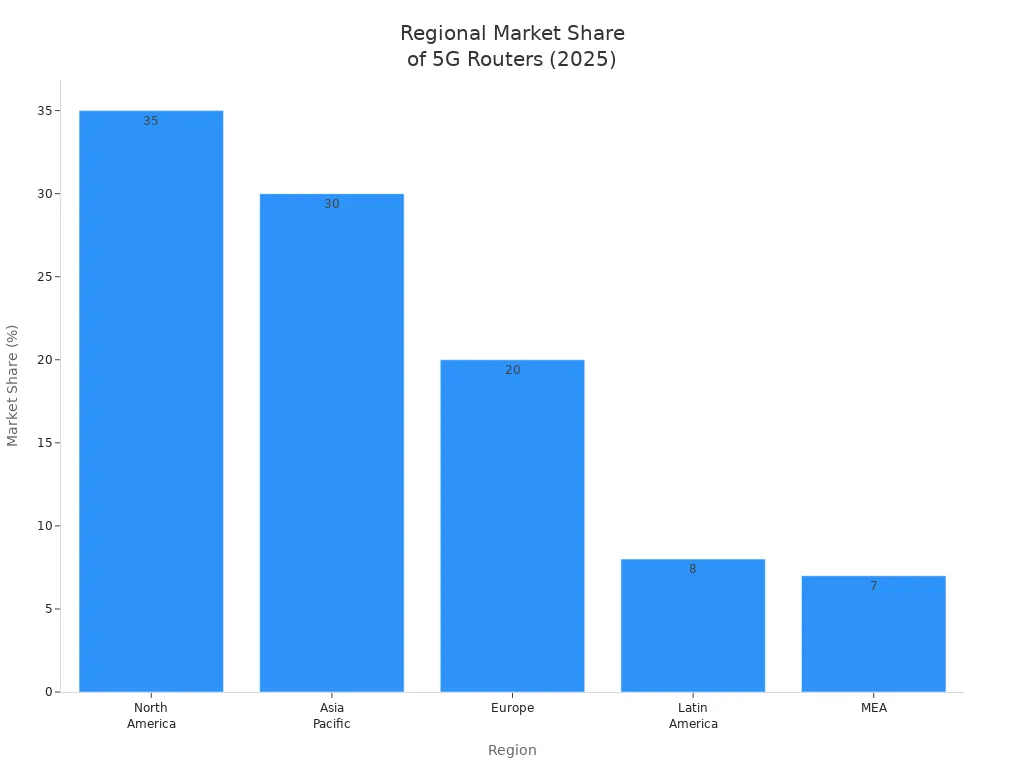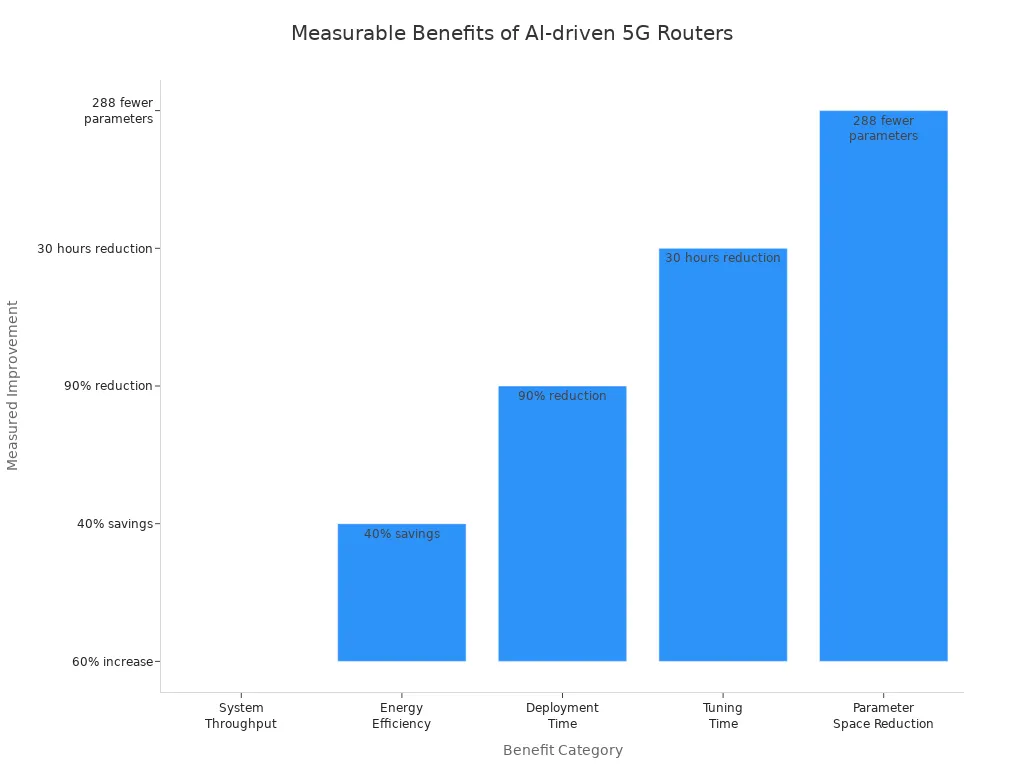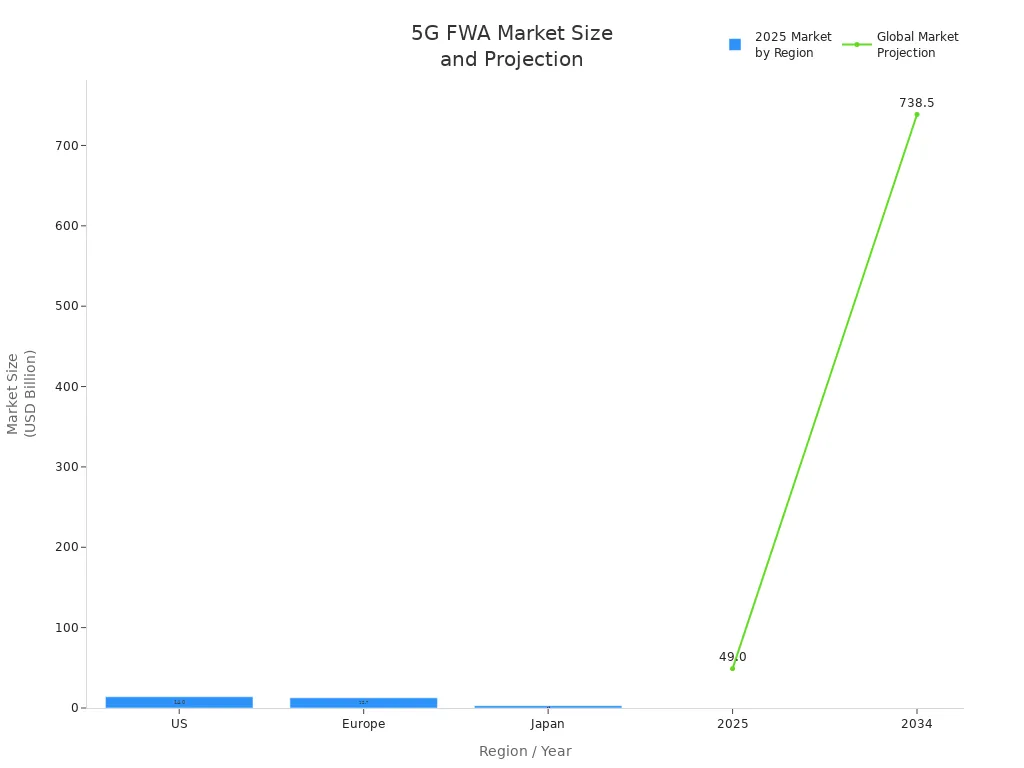
5g internet router manufacturers face a year of rapid 5g development and shifting market forces in 2025. The global mobile router market is projected to soar, with the 5g WiFi 6 router segment expected to reach nearly USD 22.9 billion by 2032.

Technological advances, surging IoT adoption, and evolving regulations drive these trends. HUASIFEI, with its global reach and deep expertise, stands at the forefront of 5g development, helping manufacturers navigate the dynamic mobile router market.

Emerging Trends in 5G Router Technology

The landscape of 5g router technology continues to evolve rapidly, with several emerging trends shaping the future of 5g development. Manufacturers must stay ahead by embracing innovation, integrating advanced features, and responding to the latest technology standards. HUASIFEI leads the way in adopting these trends, driving 5g roll-out and delivering high-speed connectivity to global markets.
Wi-Fi 7 and Next-Gen Standards
Wi-Fi 7 stands at the forefront of next-generation technology for 5g routers. This standard introduces significant advancements in speed, reliability, and security. Devices now support 320 MHz channels and Multi-Link Operation (MLO), which allows simultaneous use of multiple frequency bands for faster data transmission and lower latency. These improvements enable seamless telecommuting, immersive AR/VR, and 8K streaming, meeting the demands of modern users and businesses.
Wi-Fi 7 routers also feature built-in SIM slots for 5g connectivity, compact designs with USB-C power, and enhanced security through WPA3 encryption and parental controls.
| الميزة | الوصف | Example Products |
|---|---|---|
| Cellular Connectivity | Built-in SIM slots for 4G/5G enabling mobile hotspot use | GL.iNet Slate 7, Acer Predator Connect X7 5G CPE |
| السرعة وعرض النطاق الترددي | 320 MHz channels, Multi-Link Operation (MLO) | TP-Link Archer BE230, Asus RT-BE96U |
| قابلية النقل | Compact designs, USB-C power support | GL.iNet Slate 7 |
| الأمن | WPA3 encryption, parental controls | Netgear Orbi 770, Ziply Fiber routers |
HUASIFEI has invested heavily in Wi-Fi 7 research, developing routers that leverage these features to deliver robust 5g network services. The company’s focus on next-gen standards ensures compatibility with the latest 5g technology and supports the growing ecosystem of iot devices.
AI and Machine Learning Integration
AI and machine learning have become essential components in the evolution of 5g routers. These technologies enable predictive maintenance, optimize supply chains, and enhance energy management for both consumers and enterprises. AI-driven routers can detect potential failures early, automate complex tasks, and provide real-time insights for precision farming and smart grids.
- AI and ML enable predictive maintenance, reducing downtime in manufacturing.
- Automated factories use AI-powered robots over 5g for real-time coordination.
- AI optimizes supply chains with real-time tracking, supported by 5g-enabled iot solutions.
- Smart grids use AI to detect faults and reroute energy, improving reliability.
- AI-driven energy management benefits both consumers and businesses.
- Precision farming leverages AI and 5g to analyze sensor data for early detection of crop issues.
Manufacturers like Juniper Mist have demonstrated measurable improvements with AI-driven 5g routers, including up to 60% higher system throughput and 40% energy savings. Deployment and tuning times have dropped significantly, while operational margins improve through congestion mitigation.

HUASIFEI integrates AI and machine learning into its product lineup, ensuring routers deliver reliable, self-healing connectivity and support the expanding array of iot devices. This commitment to innovation positions HUASIFEI as a leader in 5g technology.
Network Slicing and Edge Computing
Network slicing and edge computing represent two of the most influential trends in 5g development. Network slicing divides the physical 5g network into multiple virtual slices, each tailored for specific service requirements such as bandwidth, latency, and reliability. This approach enables routers to support diverse use cases, from emergency services to industrial automation.
- The physical network divides into virtual slices, each with unique data handling rules.
- Each slice serves a specific purpose, such as video streaming or secure banking.
- A management system oversees slices, ensuring independent operation.
- Resources like bandwidth and processing power are dynamically allocated to each slice.
Edge computing adoption continues to rise, especially in sectors like automotive, manufacturing, and telecommunications. Businesses require real-time data processing and low latency, driving the integration of edge computing with 5g routers. Large enterprises lead this trend, but small and medium enterprises are quickly following, supported by flexible pricing and increased awareness.
HUASIFEI’s routers support advanced network slicing and edge computing, enabling customers to deploy scalable, high-speed connectivity solutions for urban, industrial, and rural applications. This innovation ensures optimal performance for a wide range of iot devices and services.
Open RAN and Standalone 5G
Open RAN and standalone 5g are transforming the router manufacturing landscape. Open RAN promotes cost reduction and innovation by enabling integration of components from multiple vendors through open interfaces. This approach increases interoperability and supply chain resilience, while fostering a diverse and innovative ecosystem.
| أسبكت | Benefits for Router Manufacturers | Challenges for Router Manufacturers |
|---|---|---|
| Open Interfaces | Integration of components from multiple vendors, reducing vendor lock-in | Standardization issues complicate seamless integration |
| Network Disaggregation | Specialization and innovation in specific network areas | Complexity in integration and interoperability testing |
| Software-Hardware Decoupling | Software-focused innovation, expanding market opportunities | Security concerns from increased modularity and multiple vendors |
| Supply Chain | Greater resilience by avoiding single-vendor dependency | Increased operational expenditures for managing diverse components |
| ديناميكيات السوق | Opportunities to work with a wider range of 5g components and vendors | Political and geopolitical factors may influence adoption |
| Future Enablers | AI/ML integration to optimize network management | Full benefits of AI/ML integration are still evolving |
Industry standards for Open RAN and standalone 5g continue to evolve. Large-scale deployments, such as Vodafone and Samsung’s virtualized cell sites, demonstrate practical adoption. Vendors like Ericsson and Mavenir drive open interface support and intelligent automation, while government funding accelerates ecosystem maturity. Standalone 5g networks, built on cloud-native architecture, enable advanced features like network slicing, edge computing, and automation. Routers must now integrate with cloud-native and virtualized components, supporting ultra-low latency and enhanced security.
HUASIFEI actively participates in Open RAN and standalone 5g innovation, designing routers that meet the latest standards and support flexible, programmable network management. This dedication to technology advancement ensures that HUASIFEI remains at the forefront of 5g development and emerging trends.
5G Internet Router Manufacturer Strategies
R&D and Product Innovation
5g internet router manufacturers must prioritize research and development to stay competitive in the mobile router market. HUASIFEI operates three R&D centers in Wuhan, Shanghai, and Guangzhou, focusing on new product development and advanced mobile routers. These centers drive innovation by developing routers that support Wi-Fi 7, AI integration, and Open RAN compatibility. Manufacturers who invest in technology and continuous improvement can deliver products that meet the demands of smart cities, industrial automation, and IoT expansion.
R&D teams analyze market trends and customer feedback to design routers with enhanced speed, reliability, and security. They test new hardware and software features to ensure compatibility with evolving 5g standards. This approach enables manufacturers to launch advanced mobile routers that support high-speed connectivity and low latency for diverse applications.
ODM and Customization
Original Design Manufacturing (ODM) and customization services allow 5g internet router manufacturers to address the unique needs of enterprise clients in the mobile router market. HUASIFEI specializes in ODM, offering flexible solutions for branding, hardware, and software adaptation. Enterprise clients often request:
- Customized logos, packaging, and graphics for brand identity (minimum order quantity typically 1,000 pieces).
- Tailored hardware specifications, including CPU and antenna configurations.
- Routers designed for harsh industrial environments, with wide temperature and humidity tolerance, shock resistance, and electromagnetic interference protection.
- Flexible order quantities for small brands and dealers.
- Customization of router performance, appearance, and embedded software.
| أسبكت | ملخص الأدلة |
|---|---|
| Regional Dominance | Asia Pacific leads due to telecom expansion in China, India, Japan; CAGR ~7.4% |
| Market Drivers | Demand for energy-efficient, sustainable networking solutions; innovation in networking hardware |
| Competitive Impact | ODM services enable manufacturers to scale efficiently, innovate technologically, and compete globally |
| Customization & Compliance | ODMs provide tailored solutions and adapt to environmental regulations enhancing competitiveness |
Manufacturers who offer ODM and customization can quickly adapt to changing market demands and deliver advanced mobile routers for various sectors, including smart grid, energy, transportation, and retail.
Quality and Customer Service Focus
Quality assurance and customer service play a critical role in building brand loyalty and sustaining growth in the mobile router market. HUASIFEI maintains strict quality control, using metrics such as latency, jitter, packet loss, throughput, and network speed to evaluate product performance. The company holds certifications like ISO, CE, and FCC, and complies with RoHS and REACH standards.
- Proven supplier experience (5+ years preferred)
- On-time delivery rates and rapid response times
- Factory audits and sample testing for durability, signal strength, and firmware stability
- Third-party inspections by organizations such as SGS and TÜV Rheinland
Customer service strategies influence brand loyalty. Companies like Verizon simplify setup and usage, offer transparent plans, and provide multi-year price guarantees. They bundle discounts for loyal customers and emphasize reliable network performance. Easy self-installation and strong support reduce frustration and encourage repeat business.
Manufacturers who focus on quality and customer service create a premium experience, foster trust, and build lasting relationships with clients in the mobile router market.
Global Expansion and Partnerships
Global expansion requires strategic planning and strong partnerships. HUASIFEI serves clients in over 30 countries, leveraging its expertise in advanced mobile routers and ODM services. Manufacturers expand by:
- Investing in R&D to develop customized solutions for industry-specific needs
- Forming partnerships with telecom companies to strengthen market position
- Enhancing customer service and integrating feedback for continuous improvement
- Targeting emerging markets such as South Asia, Latin America, and Africa
- Emphasizing sustainability and diversifying product offerings for niche applications
- Expanding distribution channels and improving digital marketing strategies
| أسبكت | ملخص الأدلة |
|---|---|
| Leading ODMs | Hon Hai (Foxconn), Pegatron, Quanta, Flex dominate with ~60% global market share and 150M units/year |
| Market Growth | 5G router segment CAGR ~20%, projected production >75 million units by 2028 |
| Regional Leadership | East Asia (China, Taiwan, South Korea) as global manufacturing hubs |
| Opportunities | AI and IoT integration in Wi-Fi devices, emerging markets in South Asia, Latin America, Africa |
| Competitive Advantage | Customization, modular designs, green manufacturing practices |
إن APAC region leads the mobile router market, driven by 5g adoption in China, Japan, and South Korea. Government initiatives support smart manufacturing and industrial development, creating a supportive ecosystem for manufacturers. Strategic partnerships and targeted marketing campaigns help companies capture new customer segments and expand their global footprint.
Manufacturers who embrace innovation, invest in technology, and build strong partnerships position themselves for success in the evolving mobile router market.
Mobile Router Market Dynamics

Consumer and Enterprise Demand
The mobile router market continues to expand rapidly as both consumer demand and enterprise needs drive adoption of 5g technology. The overall market is projected to grow at a compound annual growth rate (CAGR) of about 24% through 2030. Enterprise applications represent the fastest growing market segment, outpacing consumer growth. By 2025, over 1.7 billion 5g subscriptions will fuel demand for advanced 5g devices. Consumers seek portable, battery-powered routers for on-the-go connectivity, while enterprises require robust, scalable solutions for fixed locations and large device support.
| أسبكت | Consumer (Mobile Hotspot) | Enterprise (5G Router) |
|---|---|---|
| قابلية النقل | Highly portable, battery-powered | Fixed location, continuous power |
| دعم الجهاز | Fewer than 15 devices | High number of simultaneous devices |
| الأمن | Basic password protection | Advanced firewalls, VPN, zero-trust policies |
| Network Management | Minimal management | Centralized, cloud-based management |
| قابلية التوسع | محدودة | Easily scalable for expansion |
Enterprises also demand advanced security, centralized management, and cellular intelligence features. These requirements shape the 5g devices market size and forecast, highlighting growth opportunities for manufacturers.
Urban, Industrial, and Rural Applications
The mobile router market shows strong market growth across urban, industrial, and rural environments. Urban areas benefit from dense 5g coverage, supporting smart city applications and remote work demand. Industrial settings require rugged routers with features like dual SIM, eSIM, and support for legacy protocols. Manufacturers design routers to bridge old and new systems, ensuring seamless integration and reliable operation.
Rural regions face unique challenges. Nearly 60% of rural residents need device upgrades to access 5g. Governments allocate over 30% of new spectrum for rural 5g development, but only about 25% of rural populations will have reliable access by 2025. Shared infrastructure and outdoor units help overcome terrain and cost barriers. Flexible, plug-and-play routers with tri-carrier vSIM technology enable rural businesses to access high-speed internet, supporting cloud computing and digital payments.
Fixed Wireless Access (FWA) Growth
Fixed wireless access (FWA) represents a major growth driver in the mobile router market. The global FWA market size and forecast show a projected value of $49 billion in 2025, with rapid expansion expected through 2034.

The hardware segment dominates, and residential users make up the largest share. North America, Europe, and Asia Pacific lead in adoption. FWA enables high-speed broadband in areas lacking fiber infrastructure, creating new growth opportunities for 5g devices market growth factors.
Private 5G Networks
Private 5g networks create demand for specialized routers that deliver secure, scalable, and mission-critical connectivity. Industries such as manufacturing, mining, and pharmaceuticals deploy private networks to support automation, IoT, and real-time decision-making. These networks require routers with advanced security, network slicing, and low latency. Manufacturers like HUASIFEI address these needs with tailored solutions, supporting global clients in over 30 countries. The analysis of private 5g trends reveals that the mobile router market will continue to see strong market growth as enterprises seek reliable, high-performance connectivity.
Regulatory and Sustainability Trends
Spectrum and Licensing
Regulatory changes in spectrum and licensing shape the deployment of 5g routers worldwide. Governments now require manufacturers to meet strict coverage and competition obligations. For example, Germany extends usage rights in key bands and mandates rural coverage. Albania enforces a six-month deadline for spectrum use after auction. Hong Kong sets spectrum caps and demands 90% nationwide coverage within five years. Canada reserves spectrum for smaller competitors and applies a ‘use or lose’ policy. Singapore requires 50% national coverage and wholesale access for license assignments.
| Country | Regulatory Change / Obligation |
|---|---|
| Germany | Extended usage rights, rural coverage, competition promotion |
| Albania | 3.5 GHz auction, coverage obligations, six-month spectrum use requirement |
| Hong Kong | Spectrum caps, 90% coverage obligation for 2,600 MHz band |
| Canada | 3,800 MHz auction, spectrum cap, ‘use or lose’ policy |
| Singapore | License assignments in 3.5 GHz and mmWave bands, 50% coverage, wholesale access |
Regulators also issue licenses for local and private 5g networks, supporting industrial and enterprise applications. Spectrum trading and leasing allow operators to lease spectrum to vertical industries. Infrastructure sharing and network slicing optimize spectrum use, accelerating 5g infrastructure rollout and supporting new trends.
Cybersecurity and Compliance
Cybersecurity and compliance requirements differ across regions. The European Union enforces the Radio Equipment Directive (RED) 2014/53/EU, with enhanced cybersecurity provisions effective August 2025. Manufacturers must obtain RED certification, which covers network safety, data privacy, and unauthorized access prevention. SGS, a global certification body, verifies compliance for products deployed in over 100 countries.
| أسبكت | الوصف |
|---|---|
| Regional Focus | EU RED directive, cybersecurity provisions |
| Certification | RED cybersecurity certification, third-party testing |
| Standards Referenced | EN 18031-1, EN 18031-2 |
| Compliance Scope | Network safety, data privacy, radio interface security |
| Global Deployment | Regulatory alignment for worldwide deployment |
| Upcoming Enforcement | August 2025 for enhanced cybersecurity requirements |
Manufacturers like HUASIFEI comply with national and city-level high-tech standards, ensuring their 5g routers meet global regulatory mandates and protect user data.
Eco-Friendly Design
Sustainability drives innovation in 5g router manufacturing. Leading companies conduct energy audits and replace outdated equipment with energy-efficient alternatives. They integrate renewable energy sources, such as solar and wind, and adopt reduce, reuse, and recycle principles. Advanced technologies like organic solar photovoltaics and 3D printing with recyclable materials support eco-friendly production. Manufacturers also use energy-efficient chipsets, reduce hazardous materials, and follow responsible sourcing aligned with ESG standards.
HUASIFEI prioritizes energy-efficient product design and compliance with RoHS directives, contributing to lower energy consumption and enhanced corporate social responsibility.
Government Incentives
Government incentives support sustainability and innovation in the 5g router industry. Policies favor spectrum allocation and reduce deployment barriers for 5g hardware. Incentives encourage R&D investments in compact, energy-efficient, and ruggedized routers. Public-private partnerships accelerate sustainable development, while frameworks like the European Green Deal promote low-emission technologies and circular economy practices.
- Governments incentivize 5g infrastructure deployment for smart cities and sustainable development.
- Innovation grants and green technology investments foster eco-friendly router design.
- Regulatory shifts enable companies to invest in energy-efficient solutions and collaborate with academia.
These initiatives help manufacturers like HUASIFEI advance sustainability and meet evolving market trends.
Manufacturers can drive growth by focusing on innovation, compliance, and market adaptation. Key insights for each segment include:
| Market Segment | الرؤى الرئيسية |
|---|---|
| Residential | High-speed internet for smart homes and streaming. |
| المكتب | Enhanced connectivity for remote work. |
| التصنيع | Real-time IoT monitoring and automation. |
Leading companies invest in R&D, energy-efficient designs, and AI-driven management. By leveraging HUASIFEI’s advanced 5G modules and global expertise, manufacturers can meet evolving standards and seize new opportunities in the dynamic 5G landscape.
الأسئلة الشائعة
What is the projected market size for 5G WiFi routers in 2025?
The global 5G WiFi router market is expected to reach nearly USD 22.9 billion by 2032. Asia Pacific leads growth, driven by telecom expansion in China, India, and Japan. Industry analysts forecast a compound annual growth rate of about 24% through 2030.
How does Wi-Fi 7 improve router performance?
Wi-Fi 7 routers support 320 MHz channels and Multi-Link Operation (MLO). These features deliver faster speeds, lower latency, and enhanced reliability. Users experience seamless streaming, telecommuting, and AR/VR applications. HUASIFEI integrates these standards into its latest product lineup.
Why is AI integration important for 5G routers?
AI enables predictive maintenance, energy management, and real-time optimization. Manufacturers report up to 60% higher throughput and 40% energy savings. AI-driven routers support smart grids, precision farming, and automated factories. HUASIFEI uses AI to deliver reliable, self-healing connectivity.
What certifications should 5G router manufacturers obtain?
Manufacturers must comply with ISO, CE, FCC, and RoHS standards. The European Union enforces the RED directive with enhanced cybersecurity requirements effective August 2025. SGS and TÜV Rheinland provide third-party testing for global deployment.
How do government incentives support 5G router innovation?
Governments offer spectrum allocation, innovation grants, and public-private partnerships. These incentives encourage R&D in energy-efficient, ruggedized routers. Policies like the European Green Deal promote low-emission technologies and circular economy practices.